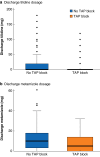Effect of transversus abdominis plane blocks in abdominoplasties on postoperative outcomes
- PMID: 40539377
- PMCID: PMC12204700
- DOI: 10.1093/bjsopen/zraf067
Effect of transversus abdominis plane blocks in abdominoplasties on postoperative outcomes
Abstract
Background: Acute postoperative pain after surgery may lead to significant complications including chronification of pain, impaired cardiopulmonary function, and increased healthcare costs. As a common and complex procedure, abdominoplasty is a key focus for pain management strategies. Although transversus abdominis plane blocks, which target the abdominal wall's sensory nerves to reduce postoperative pain by blocking nociceptive input, have shown promise in reducing postoperative pain in abdominal surgeries, their use in abdominoplasty remains underexplored.
Methods: Outcomes for patients undergoing abdominoplasty between 2013 and 2024 were analysed, comparing those who received a transversus abdominis plane block with those who did not. Postoperative analgesia followed a standardized protocol using oral narcotics and piritramide. Pain outcomes were assessed in both groups via chart review. The primary outcome, length of hospital stay, was analysed by multivariable linear regression adjusted for patient and surgical factors. Secondary outcomes, including complications and revision rates, were assessed by logistic regression. Exploratory analyses examined how reductions in medication use affected length of hospital stay and discharge timing.
Results: Overall, 192 patients who had an abdominoplasty were included in analyses: 93 had a transversus abdominis plane block and 99 did not. The transversus abdominis plane group had a significantly shorter hospital stay, with a reduction of 2.21 (95% confidence interval (c.i.) -3.07 to -1.36) days after adjusting for confounders (P < 0.001; effect size, Cohen's d 0.45). Surgical complications occurred in 46.9% of patients. The overall complication risk in the transversus abdominis plane block group was significantly reduced by 52% (adjusted odds ratio 0.44, 95% c.i. 0.23 to 0.84; P = 0.012; effect size 0.52), particularly the occurrence of haematoma (adjusted odds ratio 0.34; P = 0.031; effect size 0.66). Additionally, patients who had a transversus abdominis plane block required less postoperative medication, including lower tilidine (P = 0.038) and metamizole (P = 0.032) doses.
Conclusion: Use of the transversus abdominis plane block in patients who had an abdominoplasty was associated with improved postoperative outcomes, highlighting its potential as an effective pain management strategy and supporting its broader clinical application.
© The Author(s) 2025. Published by Oxford University Press on behalf of BJS Foundation Ltd.
Figures




Similar articles
-
Comparison of postoperative analgesic effects of ultrasound-guided intercostal nerve block and transversus abdominis plane block in patients undergoing laparoscopic cholecystectomy: randomized clinical trial.BJS Open. 2025 Jul 1;9(4):zraf022. doi: 10.1093/bjsopen/zraf022. BJS Open. 2025. PMID: 40591374 Free PMC article. Clinical Trial.
-
Perioperative transversus abdominis plane (TAP) blocks for analgesia after abdominal surgery.Cochrane Database Syst Rev. 2010 Dec 8;(12):CD007705. doi: 10.1002/14651858.CD007705.pub2. Cochrane Database Syst Rev. 2010. Update in: Cochrane Database Syst Rev. 2020 Apr 9;4:CD007705. doi: 10.1002/14651858.CD007705.pub3. PMID: 21154380 Updated.
-
Quadratus lumborum block vs. transversus abdominis plane block for caesarean delivery: a systematic review and network meta-analysis.Anaesthesia. 2021 Mar;76(3):393-403. doi: 10.1111/anae.15160. Epub 2020 Jul 4. Anaesthesia. 2021. PMID: 32621529
-
Wound Infiltration With Local Anesthetics Versus Transversus Abdominis Plane Block for Postoperative Pain Management in Gynecological Surgery: A Systematic Review and Meta-Analysis of Randomized Controlled Trials.J Minim Invasive Gynecol. 2025 Mar;32(3):229-239.e3. doi: 10.1016/j.jmig.2024.10.030. Epub 2024 Nov 5. J Minim Invasive Gynecol. 2025. PMID: 39510498
-
Erector spinae plane block for postoperative pain.Cochrane Database Syst Rev. 2023 Oct 9;10(10):CD013763. doi: 10.1002/14651858.CD013763.pub2. Cochrane Database Syst Rev. 2023. Update in: Cochrane Database Syst Rev. 2024 Feb 12;2:CD013763. doi: 10.1002/14651858.CD013763.pub3. PMID: 37811665 Free PMC article. Updated.
References
-
- Rich BA. Better late than never: the Federation of State Medical Boards model guidelines for the use of controlled substances for the treatment of pain. J Pharm Care Pain Symptom Control 1999;7:1–5
-
- Bosenberg A, Holland E. Thoracic regional anesthesia and the impact on ventilation. Pediatr Anesthesia 2022;32:380–384 - PubMed
-
- Barr LF, Boss MJ, Mazzeffi MA, Taylor BS, Salenger R. Postoperative multimodal analgesia in cardiac surgery. Crit Care Clin 2020;36:631–651 - PubMed
-
- Kehlet H, Jensen TS, Woolf CJ. Persistent postsurgical pain: risk factors and prevention. Lancet 2006;367:1618–1625 - PubMed
-
- Chapman CR, Vierck CJ. The transition of acute postoperative pain to chronic pain: an integrative overview of research on mechanisms. J Pain 2017;18:359.e1–359.e38 - PubMed
MeSH terms
LinkOut - more resources
Full Text Sources
Research Materials

